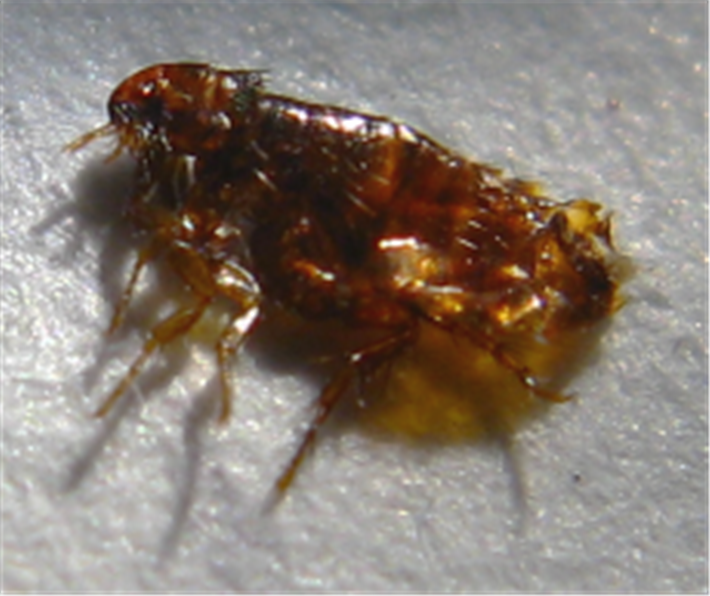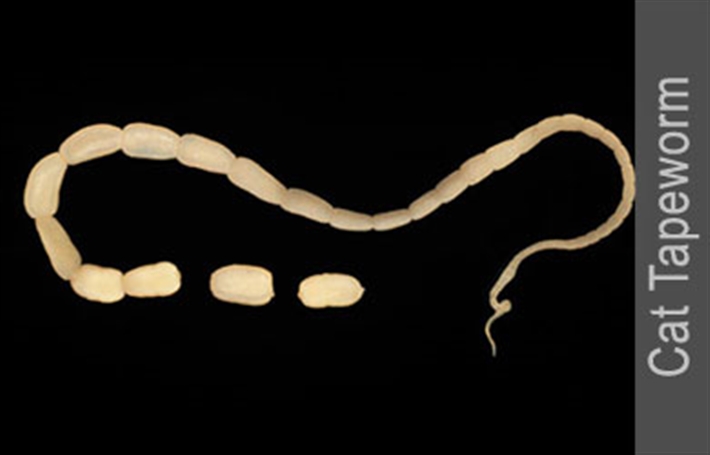Fleas & Worms
QuickLinks: Fleas | Worms | Other Parasites
Cats Protection leaflet: Fleas and Other Parasites
Fleas
 At some point, your cat will probably get fleas - don't worry, you are not the first, and you certainly won't be the last!
At some point, your cat will probably get fleas - don't worry, you are not the first, and you certainly won't be the last!
Fleas are the most common external parasite of cats. Cat fleas are about 2mm long and reddish-brown in colour, with blade-like bodies ideal for hiding in fur, and hop rather than crawl. Adult fleas live for 7-14 days, living on your cat, with females jumping off to lay up to 50 eggs a day in your carpets and soft furnishing (including your cat's bed). The larvae hatch and burrow into the furnishings. When they pupate, they can remain dormant for up to a year. They are woken by vibrations (eg footsteps), and attracted to warmth and carbon dioxide, will emerge, and jump onto your cat within seconds to continue their lifestyle - or onto you for a quick meal, even though this will stop them producing viable eggs and end their life cycle! Centrally heated homes with fitted carpets provide ideal conditions – warm and humid – for fleas to develop all year round, so there is no longer a "flea season" in most homes.
Cat Flea Life Cycle
Symptoms

 The most obvious symptom is that your cat is scratching a lot. In addition, you may notice itchy red bumps on your own ankles and lower legs ... Yes, fleas have struck. To make sure, dampen some white paper, and comb your cat over it. If you see little black specks on the paper that spread into reddish splodges, you have found flea faeces ("flea dirt"), and the red is the digested blood of your cat.
The most obvious symptom is that your cat is scratching a lot. In addition, you may notice itchy red bumps on your own ankles and lower legs ... Yes, fleas have struck. To make sure, dampen some white paper, and comb your cat over it. If you see little black specks on the paper that spread into reddish splodges, you have found flea faeces ("flea dirt"), and the red is the digested blood of your cat.
 Don't delay - treat the fleas immediately, because if you let the infestation continue, your cat will be miserable and itchy, may start over-grooming, producing bald areas, and if allergic to flea saliva, may develop scabs and red sore areas. You may find raised scabs in the fur around the tail and neck, which is called milliary dermatitis because it feels like little seeds in the fur. This needs special baths or cortisone spray to eliminate, so don't let it get this far!
Don't delay - treat the fleas immediately, because if you let the infestation continue, your cat will be miserable and itchy, may start over-grooming, producing bald areas, and if allergic to flea saliva, may develop scabs and red sore areas. You may find raised scabs in the fur around the tail and neck, which is called milliary dermatitis because it feels like little seeds in the fur. This needs special baths or cortisone spray to eliminate, so don't let it get this far!
Cause
Fleas! Fleas on the cat, fleas in the carpet, fleas in the cat bedding, fleas in YOUR bedding, fleas in the sofa....
If your cat goes outside, he will be meeting other cats, who may have fleas. Rabbit and hedgehog fleas can also live on cats. If you have bought a second hand sofa, it could come with flea eggs inside. In fact, any second hand soft furnishing could bring fleas with it. Any warm, dark place provides a safe haven for a flea. If you've just moved into a new house, flea eggs could be in the carpet, waiting to welcome you!
If you volunteer at a cat shelter, you could be bringing unwanted guest fleas home with you. If a friend has cats with a flea problem, she could be inadvertantly bringing hitchhikers in her coat or handbag
It's best to ASSUME that fleas are about, and act accordingly. Prevention is better than cure!
Prevention
If you find flea dirt on your cat, you have two problems: treat the cat, and kill the fleas and flea eggs in your house. About 95% of fleas and flea eggs in your home are NOT on your cat!
Consult your vet about the best treatment for your cat. There are several effective treatments, but which one is best for your cat depends on his medical history.
The condition should be treated by a vet but treatment will only be effective if the cat’s environment is totally cleared of both fleas and their eggs – just one flea can cause a problem in allergic individuals.
There are various elimination methods for your home, and the most suitable one will depend on your furniture and lifestyle. However, you must be prepared to repeat the elimination process several times, until all dormant eggs have hatched and died. If your cat is allergic to fleas, it only takes one flea to cause a problem. To help prevent fleas becoming established within your home it is essential that you vacuum carpets, furnishings, cracks in the floorboards and upholstered furniture to get rid of fleas and eggs. Taking great care when emptying the vacuum cleaner as fleas will still be alive. Anything that can be hot washed should be washed at least at 60°. Anything too delicate to wash (eg cushions, soft toys) should be put in the freezer to kill any fleas and eggs.
It is much better (and more cost-effective) to prevent infestation in the first place by having a regular flea treatment. Again, your vet will advise you on the one most suitable for your cat. There are sprays, collars and spot-on treatments. If your home is centrally heated, your cat will need his flea treatment monthly throughout the year to ensure no live fleas get into the house.
NEVER USE A DOG FLEA PRODUCT ON YOUR CAT AS THESE CAN BE EXTREMELY TOXIC AND RESULT IN DEATH.
To help prevent fleas becoming established within your home it is essential that you vacuum carpets, furnishings, cracks in the floorboards and upholstered furniture to get rid of fleas and eggs. Taking great care when emptying the vacuum cleaner as fleas will still be alive. If you have pets, a flea comb and regular grooming combined with weekly washing of their bedding, (ideally at above 60°C) is essential to kill fleas.
Remember that all the cats in the household must be treated as well as any dogs or house rabbits – using appropriate products for their species – to get a flea problem under control.
When to de-flea your cat
It used to be that fleas were only a problem in the summer months, but in these days of central heating, they can appear all year round. Give you cat his flea treatment on a regular day each month to ensure cover is continuous. If, fo some reason, your cat is going into a cattery, give him his flea treatment before he goes. If you are taking him to stay somewhere else, again, give him his flea treatment beforehand.
Do Indoor Cats need Flea Treatment?
Yes! Although your cat may not leave the house, fleas could come in on the clothes and bags of other cat lovers, or on your own clothes if you visit a cat-owning friend and there happens to be a flea around. And of course, if you buy second-hand furniture. Or move into a new house. Flea your cat monthly! It's not expensive and it's better to be safe than sorry - and facing a big vet bill to treat a flea allergy. Your indoor cat will be happier and healthier.
Worms
Royal Veterinary College: Worms
The two groups of internal parasites most commonly found in cats are tapeworms and roundworms, both of which live in the gut, or intestinal tract
Having worms is no fun for your cat. Symptoms can range from chronic diarrhea to lethargy. According to the Cornell University College of Veterinary Medicine, the following worms are commonly found in cats. The symptoms associated with each type are listed. You'll notice some of the same symptoms appear with different types of worms, which is why a vet must identify the exact type of worms a cat has in order to provide the right de-worming treatment.
Symptoms
If your cat is eating, but is thin apart from a distended stomach, suspect worms. Constant hunger but weight loss, with coarse, staring fur condition is a red flag - your cat needs to see the vet right away
If your can has diarrhoea, there may be bits of worms, or whole worms, visible in the stool, or around the anus, or even in the bedding.
If your cat is dragging his bottom across the carpet, it could be because of worms irritating his back end.
If you see any of these symptoms, take your cat to the vet immediately. You wouldn't want to have worms, and nor does your cat.
Ideally you don't want to get far enough to have symptoms! Regularly worm your cat as your vet advises, and stop the problem before it starts.
Cause
Animals can pick worms up in a variety of ways: From other infected animals, from eating the larvae or eggs of worms (e.g. in infected faeces or in grass), from eating raw meat, infected prey animals or infected parasites. Fleas can carry tapeworm eggs and your cat could accidentally eat such a flea while grooming his itchy skin.
 The most common worm is roundworms. These look like a white earthworm and can grow up to 10cm long. They live in the cat's gut, digesting his food, which is why a heavy worm burden leads to a starving cat with a bloated belly. The eggs pass out in the cat's faeces, and other cats can pick up worm larvae from this. The eggs can remain infectious for years. Kittens suckling from a mother cat with roundworms will also be infected via the mother's milk.
The most common worm is roundworms. These look like a white earthworm and can grow up to 10cm long. They live in the cat's gut, digesting his food, which is why a heavy worm burden leads to a starving cat with a bloated belly. The eggs pass out in the cat's faeces, and other cats can pick up worm larvae from this. The eggs can remain infectious for years. Kittens suckling from a mother cat with roundworms will also be infected via the mother's milk.
 Tapeworms are, as the name suggests, like long thin, white tapes. The head of the worm attaches to the cat's gut with hooks and digests the cat's food. Segments of the worm fill with worm eggs, and break off, and pass out of the cat's body in faeces.
Tapeworms are, as the name suggests, like long thin, white tapes. The head of the worm attaches to the cat's gut with hooks and digests the cat's food. Segments of the worm fill with worm eggs, and break off, and pass out of the cat's body in faeces.
Worm infection of humans is not common but can occur occasionally, usually in children who have ingested a flea which contains worm larvae.
Prevention
Worm treatment for cats is effective and easy. Your vet will perscribe the appropriate medication for your cat, knowing what other condtions your cat has; pregnant cats should only be medicated under a vet's supervision. Remember that fleas can carry tapeworm eggs, so treat your cat regularly for fleas too.
Clean and disinfect (using a pet-safe disinfectant) food and water bowls, and bedding regularly as well. Wash your hands thoroughly before you eat. Clean up after your pet and dispose of faeces carefully.
Indoor Cats
Because fleas can carry worms, your indoor cat should be wormed as well. It's better to be safe than sorry, and both flea and worm treatment is easy and safe, whereas elimination of parasites once they have taken hold can be more complicated.
A regular flea and worm treatment regime will keep your cat - and you! - safe and healthy.
Other Parasites
Ticks from ESCCAP (European Scientific Counsel Companion Animal Parasites)
Lice from ESCCAP (European Scientific Counsel Companion Animal Parasites)
Ear Mites from About.com
Harvest Mites from International Cat Care
Mange Mites from the Pet Place
Maggots (flystrike/myiasis) from RSPCA Cambridge